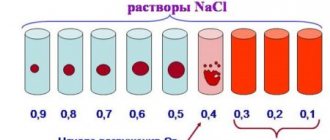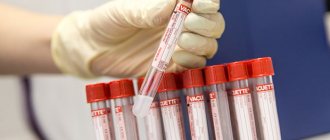Published: 02/16/2021 16:45:00 Updated: 02/18/2021
Leukocytes are the most important element of blood and the basis of the body's immunity. Our blood is red in color thanks to erythrocytes - red blood cells. For every thousand red blood cells, there is on average only one white blood cell. However, despite the small percentage, these cells play an important role in human health. They are different in function, shape, appearance. Their main task is to protect the body from viruses, bacteria, fungi and other “pests” that attack it, fight tissue damage and destroy its own aged or mutated cells. They are the foundation of the body's defenses.
Despite the fact that leukocytes are determined mainly in the blood, they are produced by a special organ – the bone marrow. Accordingly, they are formed in response to any tissue damage. This is part of a healthy, natural inflammatory response.
Types of leukocytes
Under a microscope, you can see several dozen different forms of leukocytes - different stages of maturation, or “age”.
There are 5 main groups of mature cells. Basophils are the smallest group of leukocytes. They regulate blood flow in small vessels, help other white blood cells move through tissues, and influence the growth of new capillaries. Basophils control the occurrence of allergic reactions, suppress allergens, regulate blood clotting, and neutralize toxins and poisons. When an allergen comes into contact with a basophil, this cell releases many bioactive substances responsible for the development of allergic reactions.
Eosinophils - together with basophils, they are markers of a hypersensitive reaction in the body. They also participate in allergic mechanisms, but in a different way. Unlike basophils, which cause an allergic reaction, eosinophils, on the contrary, fight it by binding foreign particles. They have antiparasitic and bactericidal activity, and are responsible for the fight against multicellular parasites - helminths. Their percentage in the blood is normal - about 1-4%. An increase in content, first of all, may indicate severe allergic conditions, helminthiasis, rheumatological diseases, and, less often, oncological pathology.
Neutrophils are a rapid response squad and the most numerous group of leukocytes (up to 80% of the total). As soon as a foreign substance (for example, a splinter, bacteria, or virus) enters the body, neutrophils immediately move to it to destroy it. They release many active enzymes towards the foreign invader and literally break down and digest any substance not related to the body - this process is called phagocytosis. Alas, having won several such battles, the neutrophils themselves die.
Monocytes are a type of large cell. They also carry out phagocytosis - they “eat” bacteria and microbes that enter the body, cleanse the blood of dead leukocytes and produce interferon. They are able to transmit information to lymphocytes about what microbe they have encountered.
Lymphocytes are the main ones in the implementation of cellular and humoral immunity. They secrete protective antibodies and coordinate the work of all other types of white cells.
As we see, leukocytes are a real army of the immune system, guarding our health. Without their correct operation, a person is defenseless against viruses, bacteria and fungi.
Monocytes
Monocytes are cells of the immune system that are among the first to respond to the penetration of aggressors into the body. If the forces of local immunity could not contain the attack of bacteria, fungi or viruses, then it is monocytes that are the first to rush to protect health.
Monocytes are formed in the red bone marrow and released into the blood. There they begin to actively function, but this does not last long, only 2-3 days. Then, using their ability to move, they move beyond the vessels through special small pores between the cells and penetrate into the tissue. There, monocytes slightly change their structure and turn into macrophages - more effective phagocytes.
Analysis for leukocytes in the blood
To determine the level of leukocytes, a classic general blood test is used - the most popular test, without which not a single examination can be done.
In addition to identifying five types of white cells, the analysis reveals the number and characteristics of red blood cells, hemoglobin, platelets and other blood components.
It is also necessary in the diagnosis of anemia, diagnosis and treatment of inflammatory processes, as an element of preventive examination, in the diagnosis of a diverse range of diseases and for monitoring treatment.
Preparing for analysis
In order for the leukogram to be the most accurate and reliable, the patient should properly prepare for the test.
- Venous blood is collected in the morning and on an empty stomach (more than 10 hours pass between the last meal and analysis). A few hours before the procedure, you are allowed to drink a glass of plain water;
- On the eve of the procedure (3 days before), it is necessary to remove fatty, smoked, spicy foods, tonics (coffee, strong tea, energy drinks) and alcoholic drinks from the diet;
- 1-2 hours before the analysis, smoking (tobacco, cigarettes, hookah), lifting weights, performing active activities and being nervous is prohibited.
After blood is taken from a vein, the material is sent to the laboratory for testing. There, a specialist determines the ratio of white cells under a microscope and compiles a leukocyte formula. Additionally, an automatic analyzer is used to obtain results.
Norm of leukocytes in the blood
Speaking about the norm of almost any laboratory analysis, you need to know that laboratories can work on different installations, use different analysis methods and different reagents.
Therefore, depending on the laboratory, reference values - the limits of normal - may vary slightly. Normally, leukocytes in the blood of adult men and women are contained in an amount of 4-9 × 10 U/l.
The content of leukocytes in the blood of a child is normally higher than that of an adult. For example, in newborns this figure reaches 9.2-13.8x10 U/l. As the child gets older, the level of white cells normally decreases. At the age of three years, the normal range is 6-17x10 U/l, and by ten years it is already 6.1-11.4 x10 U/l.
Pregnant women also often have higher white blood cell levels than normal adults. By the end of the third semester, an increased level of white cells is considered normal. This is due to the increased load on the body.
In older people, the production of leukocytes can decrease by 2-3%, and their activity and protective functions are reduced by almost half. This is one of the reasons why older people have weakened immune systems.
A deviation in the level of leukocytes in one direction or another from the norm indicates health problems. In this case, it is important to know not only the indicator of white cells in the patient’s blood in general (total quantity), but also each type of these cells separately.
The leukocyte formula in a healthy adult is as follows:
- neutrophils: band - 1-5%, segmented - 40-70%;
- lymphocytes – 20-45%;
- monocytes – 3-8%;
- eosinophils – 1-5%;
- basophils – 0-1%.
Interpretation and normal values of the main blood test parameters
| How is it designated? | What does it mean | Norm for women | Norm for men |
| R.B.C. | Red blood cells | 3,5-4,5 | 4,0-5,5 |
| WBC | Leukocytes | 4-9 | |
| PLT | Platelets | 180-320 | |
| HGB | Hemoglobin | 120-140 | 130-170 |
| MCV | Average erythrocyte volume | 82-98 | 81-95 |
| MCH | Average HGB level in erythrocyte | 26-32 | |
| MCHC | Average concentration of red blood cells in HGB (%) | 31-38 | |
| HCT | Hematocrit (in%) | 35-44 | 40-50 |
| RET | Reticulocytes (%) | 0,2-1 | |
| ESR | ESR (mm/h) | 2-15 | 1-10 |
| CPU | Color | 0,85-1,05 | |
Elevated leukocytes in the blood
Leukocytosis occurs as a consequence of pathological processes.
When aggressors invade the body, it releases a large number of white cells into the blood to fight the threat. Leukocytosis can be observed in the following pathological processes:
- infectious diseases of any nature (including infection with viruses and purulent infections);
- against the background of chronic inflammatory processes;
- for some cancers;
- for allergic reactions;
- in the presence of parasites in the body;
- in situations where the protective barrier of the skin is damaged (with large-scale burns and frostbite).
There are a number of conditions that are not associated with diseases, but in which the level of leukocytes in the blood also increases.
We are talking about severe stress, smoking and strict diets. There are also several physiological conditions that naturally cause elevated readings. As we described above, in pregnant women, leukocytes increase closer to childbirth. The indicator rises immediately after eating and returns to normal after a few hours - so it is important to donate blood at least 5 hours after eating. A bath or sauna and vigorous physical activity before the test can also raise the level of white blood cells.
To get a reliable result, a general blood test must be taken strictly in a calm state on an empty stomach.
Eosinophils
Eosinophils are a small number of white blood cells that are found in human blood and tissues. They are an indispensable element that provides immunity.
Like other white blood cells, they are formed from bone marrow, and their progenitor is a single stem cell. The norm is 1–4%.
In total, eosinophils live about 12 days, but do not spend all of this time in the bloodstream. After 3-4 days of ripening, they enter the bloodstream and remain there for only 6-12 hours. Then they pass into the tissues and accumulate in especially large quantities in the lungs, under the mucous membrane of the digestive tract, and in the skin.
When the number of eosinophils increases, the condition is called eosinophilia, and the reverse change is called eosinopenia. As a rule, bright changes are symptoms of diseases, but some physiological fluctuations in their number are possible within normal limits. For example, an increase and decrease in eosinophils can be observed depending on the time of day; at night they are usually most in the blood.
Low leukocytes in the blood
A condition characterized by a low level of white cells in the blood is called leukopenia.
Quite often it is temporary, but if the indicator is consistently low, this may indicate serious pathologies. A low level of leukocytes in the blood may be due to the following reasons:
- damage to the bone marrow (for example, radiation), in which it is not able to produce the required number of white cells;
- disturbances in blood circulation;
- too rapid breakdown of leukocytes;
- consequences of chemotherapy;
- autoimmune and rare hereditary diseases;
- taking certain medications;
- strict diets.
To restore the normal value of leukocytes, it is necessary to discover the primary cause of the pathology.
Neutrophils
Neutrophils come from red bone marrow, they are formed from a single stem cell, which is the ancestor of all blood cells. However, stem cells do not immediately turn into neutrophils. Between these two forms there are several stages, several intermediate forms.
There are 6 types of neutrophils:
- myeloblasts;
- promyelocytes;
- myelocytes;
- metamyelocytes;
- band neutrophils;
- segmented neutrophils.
Most of all is in the blood of the latter. They are present in an amount of 40–75% of the total number of leukocytes. The number of rod-shaped neutrophils is significantly smaller, they can be 1–6%. The number of young cells does not reach 1%.
Interesting Facts
- Species of white bodies vary in life expectancy. Neutrophils, for example, protect us for only a few days, while tissue macrophages protect us for several years. Cells that live in the blood live shorter than those that live in tissues.
- A complete blood count determines five types of leukocytes. In fact, there are dozens of cell forms that are essentially immature forms of the main five types.
- Leukocytes interact with each other. They transmit information to each other, trigger the activity of different types of white cells, and control their own mortality and fertility. This is an entire intelligent city that provides our protection.
- Although leukocytes are called “white cells,” they are actually transparent.
Author:
Baktyshev Alexey Ilyich, General Practitioner (family doctor), Ultrasound Doctor, Chief Physician
What does a shift in the leukocyte formula to the left and to the right mean?
Neutrophils form the body's antibacterial and antifungal defenses, and when a certain microbe enters the body, the number of neutrophils increases. In this case, not only their total number changes, but also the number of individual forms of these cells.
Chain of neutrophils arranged according to maturation:
Young - rod-nuclear - segmented.
A shift of the formula to the left is an increase in the number of young cells, and a shift to the right is an increase in the number of old cells.
Reasons for the shift in leukocyte formula
In medical practice, a shift to the left occurs more often. This is affected by the presence of an acute bacterial or fungal infection in the body. The bone marrow is mobilized to protect the body and begins to intensively produce neutrophils. They begin to fight the infection and die in the process. Young cells are produced to replace mature cells. At a certain point, the number of young cells exceeds the number of mature ones.
An increase in segmented neutrophils leads to a shift in the leukocyte count to the right. This occurs not only against the background of an increase, but even more often with a decrease in the number of leukocytes. This is facilitated by long-term chronic infections, in which bone marrow reserves are depleted and young cell forms cease to form. Poisoning, radiation, chemotherapy and radiotherapy, which also suppress the bone marrow, can cause the correct shift.
To prevent changes in the number of leukocytes and changes in the leukocyte formula, you need to monitor your health. To maintain your immune system, you should exercise, maintain a work-rest schedule, eat right, and avoid stressful situations. Also, do not forget about undergoing a routine examination with a therapist.
Definition and Purposes of Purpose
CBC (complete blood count) is a laboratory diagnostic method for assessing the condition of the body and searching for the source of pathology. This test can be prescribed by a doctor of any specialty. In what cases is OAC prescribed:
- For prevention during medical examinations. The composition of the blood is relatively constant and rarely goes beyond the normal range in a healthy person. And some diseases may not affect your well-being for a long time, and then a preventive test will become a reason for subsequent examination.
- When the first symptoms of illness appear. Analysis in this case can make it possible to determine the nature of the disease, the degree of intensity of inflammation or an allergic reaction.
- OAC may be re-prescribed to monitor the course of the disease over time. Also to assess the effectiveness of the therapy.









